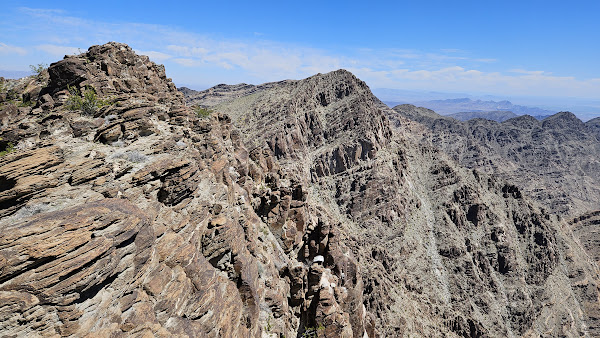Distance: 6.3 miles round trip on dirt road and cross country
Summit Elevation: 3381' (Big), 3380' (False)
Elevation Gain: 2809'
Elevation Gain (in Empire State Buildings): 2.2
Round trip time: 6 hours 10 minutes
Recommended water: 112 oz.
Parking/Fees: Free on Midland-Vidal Road
Difficulty: Strenuous
Day two of my Blythe area trip was dedicated to Big Maria (DPS #92) and False Maria, the two highest points in the Big Maria Mountains. False Maria is one foot lower than Big Maria. I followed the DPS driving directions, going north on Midland-Vidal Road. The road requires high clearance and I recommend 4x4 to deal with wash crossings. The road was really rough near the end and I parked at a convenient turn around spot about 0.2 miles from the official starting point. The approach was over rocky open desert to the major drainage. The lower part was boulder clogged, but at least it was solid granite. While some might be loose, at least the rock would not crumble under you. The DPS guide classifies it as class 1, but I had to use my hands often to get over and around stuff. Side gullies came in from all sides and some were tempting as I could see clear lines to blue sky. However, most didn't lead to advantageous spots on the ridge. The middle part of the drainage was more open and I made better time.
The crux was the upper drainage which got very steep with loose dirt and fewer rocks for aid. I was nearly to the top when I realized the route was in the gully left of me. I didn't want to descent three hundred feet to get back on route so I hoped I could find a way to the main ridge. When I hit the top, I could see Big Maria and the connecting ridge. I was able to side hill safely around the top of the bump to reach the ridge. It had worked out nicely. The ridge was a welcome change and mostly easy desert. The climb to the saddle between Big and False was a little over a half mile, filled with minor bumps. Some could be skirted, some had to be climbed over. When I got to the saddle, neither summit was visible. I rested and refueled there. After crossing a small rise, Big Maria came into view, looking more massive than it appeared in photos. Twenty minutes later, I was on the summit with expansive views of the desert and distant farmland. The summit had been without a register for years, but a gray plastic box held a new DPS register from January, 2024. I was the third entry in the book. I had packed the drone and flew it briefly, but the video was wobbly due a problem with the gimbal. I was able to salvage a few stills, but it will need to be repaired.
It was close to 10:30 AM and despite the rising heat, False Maria seemed too close to let go. I set out at a determined pace and made it to the top of False Maria in good time. I signed the much older and fragile register there dating back to the late 1990s. I headed back and took the main route down. This involved going over the major bump to reach the descent gully. It was very steep at the top and I had better luck sticking close to the right wall where I could get some assistance. I was less concerned with route finding on the way down, taking class 3 options if they saved time. I didn't descend the gully I came up, but it seemed better and more direct than the main route. It also avoided having to go over the big bump before the ridge. I would use my ascent path both ways if I came back. The boulder free middle section had long granite slabs that sounded hollow under my pole. It's the sound of decaying rock you don't want to hear when rock climbing, though not a safety issue in this instance. I took one break in a rare shady spot on the way down. The rocks were getting warm to the touch over the last mile. Big Maria was immensely satisfying and hit the sweet spot for duration and difficulty.






















































